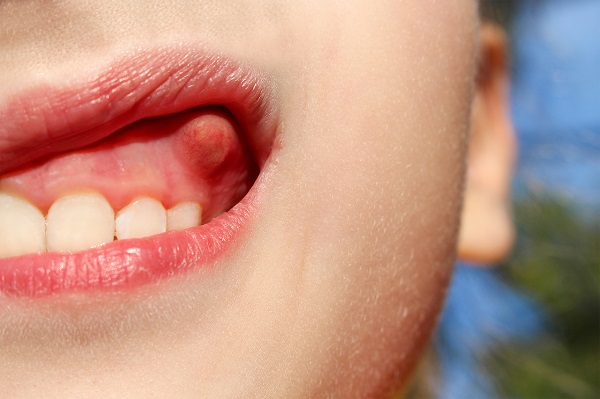A toothache or that uncomfortable feeling when you bite into cold, delicious ice cream can foretell the approach of a dental abscess. If ignored, this abscess can bring more than pain and discomfort. Extreme cases can feature interference with your eating and even breathing. Untreated abscesses can put you at risk for sepsis, an extreme set of measures your body takes to infection. Sepsis kills an estimated one in three people globally and can lead to organ failure, chronic pain, fatigue, and even amputations. Below, we present the causes of a dental abscess, its symptoms, and how you can get it treated.

What Is a Dental Abscess?
A dental abscess consists of a pocket of accumulated pus. These pockets of thick, yellowish fluid take residence usually at or near the bottom of the tooth. Two forms of this abscess arise, based upon where they are located.
In a periapical abscess, the pus congregates at the tip of the tooth root. You can also think of this as a tooth related abscess because it happens in the interior of the tooth. The nerves of the tooth have either died or are dying. A periodontal abscess carries the alternate name of gum abscess because it forms within the gum next to the root.
Abscesses ironically are the results of the body’s response to an attack from bacteria. Specifically, tooth abscesses create a fortress to prevent the infection from spreading to other parts of the body.
Tooth Abscess Causes
As with many oral diseases, dental abscesses are creations of bacterial infections. For periapical abscesses, the infection attacks through a cavity that is not filled or otherwise treated. Bacteria can enter the root tip due to an injury, namely an impact to the mouth from playing sports or other reasons.
Gum-related abscesses develop from trapped and otherwise unremoved food in the gum where the infection festers. The combination of bacteria and the food, sugar, or other particles produces a filmy plaque.
Whatever the type, abscesses and the infections that spur them are the consequences of poor dental habits such as not brushing your teeth. Sugary beverages, desserts, and candies, along with starchy foods (for instance, white potatoes, potato chips, white bread, and other carbohydrates stripped of fiber) encourage bacterial growth, especially when left on teeth.
Sugars and starches are also major contributors to diabetes. Those who suffer from diabetes have a more difficult time warding off infections.
Dental Abscess Symptoms
Pain stands out as a sign of a dental abscess. You will feel it often suddenly and with considerable intensity. It throbs and will slowly but almost surely worsen. The pain can branch out to your neck, ear, and jawbone, usually on the same side as the abscessed tooth or gum. It can interfere with your sleep in that you feel heightened pain when you’re lying down.
Other dental abscess symptoms include:
- Facial swelling and redness
- Gums that are red, shiny, and swollen
- Fever
- Bad breath, typically from the presence of pus. Also, it may result from a sudden flow of fluid when the abscess ruptures. You may experience relief from the pain, but this is accompanied by the salty, bad smell and poor taste of the fluid from the rupture.
- Your teeth feel sensitive when exposed to hot or cold temperatures, such as from drinking coffee or cold beverages, or from eating ice cream or very hot foods. Sometimes, your intake of cold air can also trigger tooth sensitivity.
- A potentially affected tooth becomes tender, stained, loose, or a combination of these.

Dental Abscess Treatment
Signs of the onset of a dental abscess should prompt an immediate contact or trip to the dentist. Even before you see the dentist, you might try to relieve the pain through ibuprofen or aspirin.
A temporary homemade remedy comes via a saltwater solution. Mix 1/2 teaspoon of salt and 8 oz of water. With this concoction, you hope to draw the pus away from the abscess area and alleviate the pressure that causes the pain.
Treatment by the dentist for a dental abscess will often start with a cleaning of the abscessed area. From there, you will have a root canal. In this procedure, the dentist creates a small pathway through the crown, or top part of the tooth, to the pulp chamber and root canals. Through the opening, the chamber and canals can be cleaned, shaped, and filled to seal the root canals. Part two of the process, which occurs in a subsequent visit, involves the restoration of the tooth through a crown or some other protective material.
Sometimes, the damage may be such that the tooth has to be removed.
Preventing a Tooth Abscess
As an abscessed tooth is a creation of infections and bacteria, your prevention strategy involves proper oral hygiene and diet. Specifically, take these actions:
- Drink fluoridated water and brush your teeth with fluoridated toothpaste.
- Brush at least two times daily, especially after the first and last meals. Brushing sessions should last at least two minutes. Also floss, preferably at night, so that food particles do not rest in your mouth while you are sleeping.
- Replace your toothbrush every three to four months. Worn bristles can render your brushing efforts ineffective.
- Reduce sugar and unhealthy starches in your diet. Foods with good carbohydrates, particularly those high in fiber that can reduce the chance or effects of diabetes, include whole-grain rice, whole grain pasta, and whole wheat bread.
With the prospect of pain and discomfort that accompany a tooth abscess, you should take this condition or any sign of it very seriously. Should you sense the possibility of a dental abscess, do not delay seeking dental attention. Share with us your experiences in dealing with and being treated for dental abscesses down below.

Leave a Comment